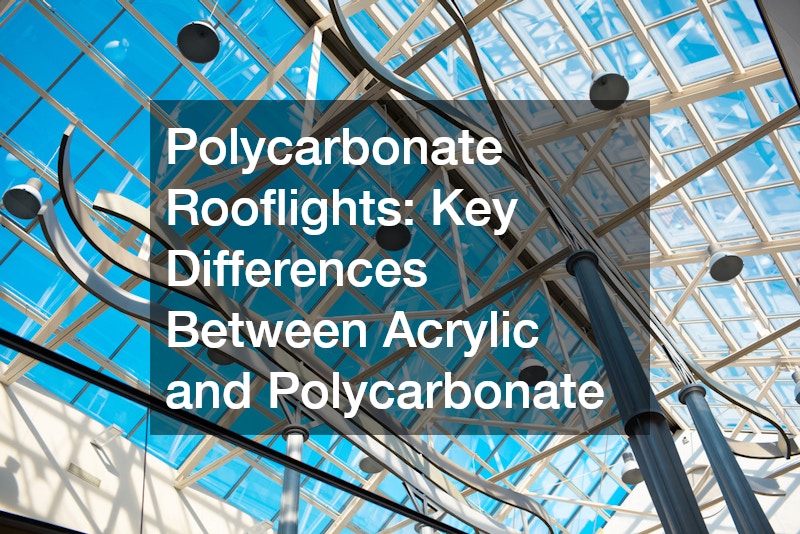

When it comes to selecting materials for rooflights, especially polycarbonate rooflights, homeowners and builders often find themselves comparing two popular options: acrylic and polycarbonate. While both materials appear similar at first glance and clear, lightweight, and durable, there are significant differences in their properties that can impact their performance. These differences are especially relevant when choosing materials for polycarbonate rooflights or polycarbonate dome rooflights, which require a balance of strength, clarity, and weather resistance.
In this article, we will explore the key distinctions between acrylic and polycarbonate, covering factors like outdoor reliability, clarity, strength, workability, and cost, all to help you make the right decision for your next project.
1. Reliability in Outdoor and Indoor Environments One of the most important considerations when choosing between polycarbonate and acrylic is how well they perform in different environments.
Both materials are generally stable indoors, withstanding standard indoor conditions without issues. However, when used outdoors, where rooflights are most commonly installed, their performance varies.
Acrylic, known for its excellent UV resistance, outshines polycarbonate in environments with significant sun exposure. Its natural UV stability makes it a popular choice for outdoor use, especially in regions with high sunlight levels. This UV resistance means acrylic will retain its clarity for a longer period, with some manufacturers offering warranties of up to 30 years against discoloration.
Polycarbonate, on the other hand, is more sensitive to UV rays. To counteract this, manufacturers often apply UV-resistant coatings on both sides of polycarbonate sheets. For instance, polycarbonate dome rooflights typically come with a 10-year warranty when these coatings are used. However, despite the coating, acrylic remains superior for UV stability, making it a better long-term option for outdoor use in sunny climates.
2. Clarity of Material For rooflights, clarity is a crucial factor since the primary function is to allow natural light to filter through. Both acrylic and polycarbonate are available in clear options, but acrylic has a slight edge when it comes to optical clarity.
Acrylic is known for its glass-like transparency and smooth surface, which provides excellent see-through visibility. When polished, its edges can also be made completely clear, making it an ideal choice for applications where visual aesthetics are a priority, such as in retail or architectural settings.
Polycarbonate, while also clear, tends to have a slight tint. Although this tint is usually barely noticeable from a distance, it can affect overall clarity in some applications. However, for most rooflight applications, especially polycarbonate rooflights, the difference is negligible and does not significantly impact the amount of light transmitted.
3. Strength and Durability When it comes to strength, polycarbonate easily takes the lead. It is known to be around 100 times stronger than glass, making it highly impact-resistant. This makes polycarbonate dome rooflights an excellent choice in environments where strength and durability are paramount, such as in areas prone to storms, hail, or other harsh conditions. Polycarbonate’s incredible toughness also ensures that even under high-impact situations, it will not shatter or break easily, maintaining its structural integrity.
Acrylic, while still much stronger than traditional glass (around 10 times), is more prone to cracking or breaking under significant stress. It doesn’t shatter like glass, but it’s not as resilient as polycarbonate, especially when subjected to force. For situations where strength is critical, such as in industrial or high-impact environments, polycarbonate rooflights are generally the better choice.
4. Workability and Fabrication The workability of a material refers to how easy it is to cut, drill, and shape it during installation or manufacturing processes. Both acrylic and polycarbonate are relatively easy to work with, but there are some notable differences depending on the task.
Polycarbonate is generally easier to machine and drill due to its strength and flexibility. Standard drill bits can be used without the risk of cracking the material, even when drilling close to the edges. This makes polycarbonate an ideal choice for projects that require precise fabrication, especially in roofing applications where holes might need to be drilled for fasteners.
Acrylic, on the other hand, requires more specialized tools for drilling and cutting to avoid cracking or chipping, especially when working near the edges. However, when it comes to thermoforming the process of heating and molding the material acrylic is more user-friendly. Acrylic can be reshaped multiple times if mistakes occur during the fabrication process, while polycarbonate must be pre-dried to remove moisture before forming, making it a bit more challenging to mold.
5. Flexibility and Forming Capabilities Flexibility is another critical factor for rooflights, especially polycarbonate dome rooflights, where the material needs to adapt to various shapes. Both acrylic and polycarbonate offer a degree of flexibility, but polycarbonate is far more flexible. It can be pressure-formed and molded into complex shapes without cracking, making it the preferred option for domed rooflights or other intricate designs.
Acrylic has some flexibility but is more likely to crack if bent too far or subjected to excessive pressure. For projects requiring complex shapes or high flexibility, polycarbonate wins out.
6. Fire Resistance In terms of fire certification, polycarbonate also has an advantage. It generally meets higher fire resistance standards than acrylic, particularly in large-scale or public projects. Polycarbonate’s fire ratings make it suitable for use in environments where fire safety is a concern, such as commercial buildings or industrial facilities.
7. Price and Cost-Effectiveness Lastly, cost is always a significant factor. Acrylic is typically less expensive than polycarbonate, which makes it an attractive option for budget-conscious projects. Because acrylic is produced in larger quantities, it is often the more economical choice for simple, straightforward applications where strength and extreme durability are not as critical.
Polycarbonate, while more expensive, offers superior strength and flexibility, justifying the higher cost in projects that demand these qualities.
Conclusion When deciding between acrylic and polycarbonate for your rooflight needs, it’s essential to consider the specific requirements of your project. For polycarbonate rooflights and polycarbonate dome rooflights, polycarbonate’s superior strength, flexibility, and fire resistance make it the preferred option for high-impact and complex applications. However, if clarity, UV resistance, and cost are more important, acrylic may be the better choice. Ultimately, each material has its strengths and trade-offs, so understanding these key differences can help you make the best decision for your project.
.



